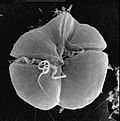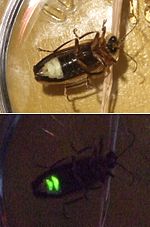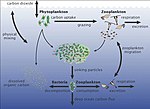 | The dinoflagellates (Greek δῖνος dinos "whirling" and Latin flagellum "whip, scourge") are a monophyletic group of single-celled eukaryotes constituting... 95 KB (10,290 words) - 21:17, 10 May 2024 |
 | Luciferase (section Dinoflagellate) examples in other kingdoms including bioluminescent bacteria, and dinoflagellates. The luciferases of fireflies – of which there are over 2000 species... 27 KB (2,896 words) - 13:08, 29 March 2024 |
 | Bioluminescence (redirect from Dinoflagellate light production) The most frequently encountered bioluminescent organisms may be the dinoflagellates in the surface layers of the sea, which are responsible for the sparkling... 74 KB (8,013 words) - 15:46, 11 May 2024 |
Dinoflagellate Blooms is the fourth studio album that J. G. Thirlwell has issued under the pseudonym Manorexia. It was released on June 11, 2011 by Ectopic... 3 KB (113 words) - 03:56, 13 January 2021 |
Calcareous dinoflagellate cysts or calcareous dinocysts are dinoflagellate cysts produced by a group of peridinoid dinoflagellates, called calcareous... 6 KB (720 words) - 02:33, 16 May 2023 |
Dinocyst (redirect from Dinoflagellate cyst) Dinocysts or dinoflagellate cysts are typically 15 to 100 μm in diameter and produced by around 15–20% [citation needed]of living dinoflagellates as a dormant... 87 KB (9,312 words) - 21:16, 10 May 2024 |
 | named for Dr. Karen Steidinger for her exceptional contributions to dinoflagellate research. She has spent many decades researching Karenia brevis. 12... 12 KB (1,488 words) - 01:18, 13 March 2024 |
Dinodnavirus is a genus of viruses that infect dinoflagellates. This genus belongs to the clade of nucleocytoplasmic large DNA viruses. The only species... 3 KB (298 words) - 04:16, 19 August 2023 |
Dinoflagellate/viral nucleoproteins (DVNPs) are a family of positively-charged, DNA-binding nucleoproteins found exclusively in dinoflagellates and Nucleocytoviricota... 2 KB (281 words) - 19:40, 3 December 2023 |
 | Scintillon (section Dinoflagellate light production) produce light. Among bioluminescent organisms, only dinoflagellates have scintillons. Marine dinoflagellates at night can emit blue light by bioluminescence... 10 KB (1,282 words) - 12:41, 7 January 2023 |
 | Zooplankton (section Dinoflagellates) zooplankton, including zooflagellates, foraminiferans, radiolarians, some dinoflagellates and marine microanimals. Macroscopic zooplankton include pelagic cnidarians... 76 KB (7,030 words) - 05:39, 28 April 2024 |
 | (e.g. Shewanella hanedai and Shewanella woodyi) Protists Certain Dinoflagellates (e.g. Noctiluca scintillans, Pyrodinium bahamense, Pyrocystis fusiformis... 9 KB (561 words) - 00:34, 6 May 2024 |
 | Microfossil (section Dinoflagellate cysts) complexity. Some dinoflagellates produce resting stages, called dinoflagellate cysts or dinocysts, as part of their lifecycles. Dinoflagellates are mainly represented... 61 KB (6,330 words) - 03:19, 16 February 2024 |
 | Ceratium (category Dinoflagellate genera) (about 7) of freshwater dinoflagellate species. Previously the genus contained also a large number of marine dinoflagellate species. However, these marine... 14 KB (1,465 words) - 00:58, 13 March 2024 |
 | Bacterial DNA binding protein (redirect from Dinoflagellate histone-like proteins) group of eukaryotes known as dinoflagellates. These dinoflagellate histone-like proteins replace histone in some dinoflagellates and package DNA into a liquid-crystalline... 19 KB (2,263 words) - 01:58, 11 December 2023 |
 | unicellular species of green algae, many golden algae, euglenids, dinoflagellates, and other algae have become heterotrophs (also called colorless or... 91 KB (10,509 words) - 17:38, 29 April 2024 |
 | Marine microorganisms (section Dinoflagellates) radiolarians can be in symbiosis with dinoflagellates The dinoflagellate Dinophysis acuta Dinoflagellates Dinoflagellates often live in symbiosis with other... 232 KB (21,384 words) - 06:01, 14 April 2024 |
 | For example, Gymnodinium nagasakiense can cause harmful red tides, dinoflagellates Gonyaulax polygramma can cause oxygen depletion and result in large... 29 KB (3,353 words) - 05:38, 22 April 2024 |
Allen Place (section Dinoflagellate toxicity) full-length cDNA library for a dinoflagellate species, and his team obtained the complete transcriptome of several dinoflagellates, providing sequence information... 19 KB (2,017 words) - 10:28, 15 May 2024 |
 | Luciferin (section Dinoflagellate) blue light emission. Dinoflagellate luciferin is a chlorophyll derivative (i. e. a tetrapyrrole) and is found in some dinoflagellates, which are often responsible... 9 KB (867 words) - 20:20, 25 April 2024 |










